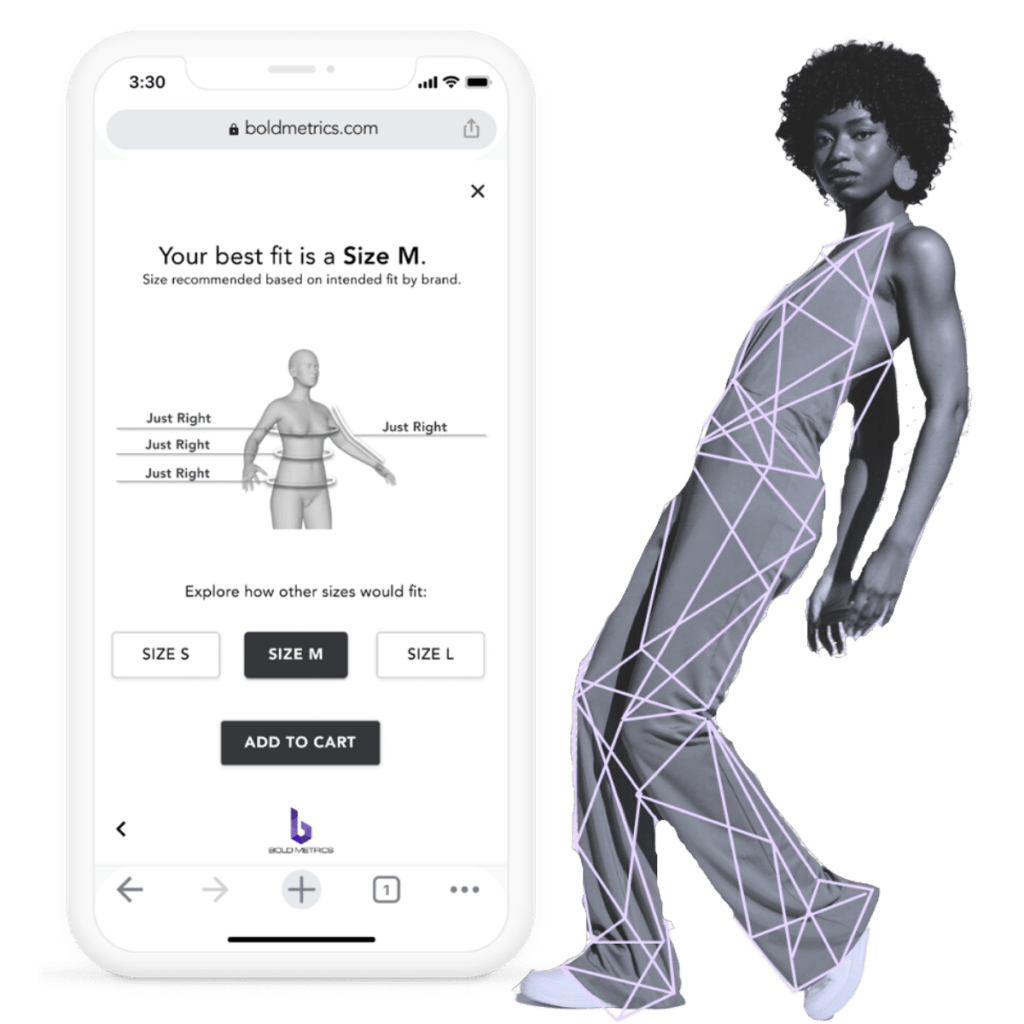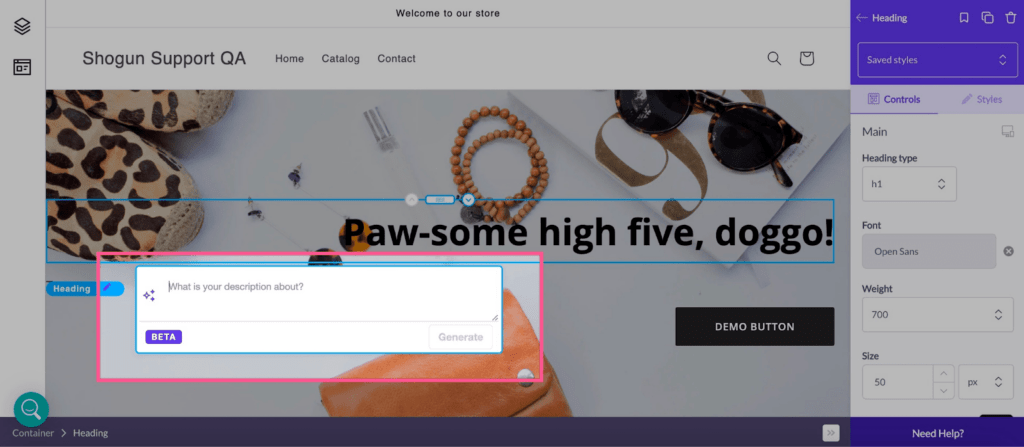Ecommerce AI: 10 Smart Use Cases of Artificial Intelligence in DTC

The artificial intelligence market is booming.
Stories of a new AI tool emerge on a daily basis, hence why experts predict the AI market will be worth almost $2 trillion by 2030. (That’s a stark increase from the $95 million valuation in 2021.)
Ecommerce merchants—who are often bogged down by manual, repetitive tasks—are turning to AI to streamline their to-do list and offer better customer experiences.
But how do you decide which responsibilities are better placed in the hands of a machine? And which tools should you trust to deliver the same seamless shopping experiences your human team has perfected?
This guide shares how AI is transforming the ecommerce landscape, complete with 10 examples of how you can leverage AI technology for your online store.
We’ll cover:
#cta-visual-pb#<cta-title>Build your store without coding<cta-title>Design the store of your dreams without writing a line of code with Shogun Page Builder.Get started for free
Artificial intelligence and ecommerce: An ever-changing landscape
The world of artificial intelligence has come a long way since its origin back in 1921 when Czech playwright Karel Čapek explored the idea of “artificial people” (referred to then as robots).
The AI revolution was initiated a few decades later when in 1950, mathematician Alan Turing published a research paper titled Computer Machinery and Intelligence. In the report, Turing wrote: “I propose to consider the question, ‘Can machines think?’”
Fast forward to today and AI has become a part of our everyday lives. Studies show that almost half of all businesses have adopted some kind of AI.
Voice assistants like Siri and Amazon Alexa use machine learning to control other devices in our homes.
Apple uses facial recognition to unlock devices; most of us chat with a chatbot every time we contact a business.
What does this mean for ecommerce companies?
While the future of AI is still unclear thanks to the rapid progression of tools like ChatGPT, consumers seem to have bought into the idea of using AI throughout the shopping journey.
One study found 47% of people were (somewhat or very) comfortable with AI targeting advertising to shoppers.
That said, acceptance of AI seems to decline with consumers’ age. Some 85% of Generation Z are comfortable with brands using AI for ecommerce personalization, compared to just 57% of Baby Boomers.
The reality is: we’re only just beginning to understand AI’s impact on ecommerce.
But some daring businesses are testing the waters and putting both repetitive and complex tasks into the hands of an AI platform.
Benefits of using ecommerce AI
Now that we know what ecommerce AI looks like, let’s explore the benefits of using this type of ecommerce automation technology.
- Better targeting. Artificial intelligence is a whiz at interpreting data into something that’s easier for us to understand. Ecommerce marketers, for example, can input customer data into an AI tool and find common topics an audience talks about, the influencers they follow, and what social media trends it expects to see in the coming months.
- Reduce human error. Take the complex task of order fulfillment. Unlike humans, who sometimes make mistakes, some companies report 99% accuracy when using AI-assisted picking machines.
- Increased team productivity. Research from Stanford found that AI can improve employee productivity by up to 14%. Why? Because AI can handle time-consuming, repetitive tasks—like creating product descriptions, imagery, or translations for your ecommerce store.
- Cost savings. When your ecommerce team doesn’t have to waste time on repetitive tasks, they have more free time to focus on higher-impact tasks. Around a quarter of companies that use ChatGPT report savings of $50,000 to $70,000. (One in 10 say they’ve saved upwards of $100,000.)
10 AI use cases in ecommerce (with examples from real brands)
While AI has come into stark relief lately, brands have already been using it for various ecommerce tasks. Below, you’ll see the many ways that AI can help with the rote responsibilities of your day in ways that are both cutting edge and so last year.
1. Personalized product recommendations
Personalized shopping experiences are the expectation, not the ideal scenario.
Studies show that two-thirds of consumers expect brands to understand their individual needs, and more than half think merchants can improve the shopping experience by making product discovery easier.
It’s why ecommerce brands that use personalization see a $20 ROI for every dollar spent.
How do you provide personalized online shopping experiences to the hundreds (if not thousands) of people accessing your ecommerce site?
Inyouths leans on artificial intelligence. Its co-owner Kevin Wang says: “Understanding that shopping for mirrors, especially of the custom LED type, can be a complex task for some, we use AI to simplify the journey.”
“Leveraging machine learning algorithms, our platform analyzes customers’ browsing behavior, purchase history, item preferences, and even the time they spend looking at specific mirrors. Based on this data, the AI then generates personalized product suggestions that cater to each individual’s tastes and requirements.”
The product recommendation widget boasts impressive results.
Kevin adds: “Since we started using the machine learning recommendation engine, we’ve seen an increase in customers’ average order value and a decrease in bounce rates—a clear indication of improved customer engagement on our website.”

2. Smart search engines
Friction in the product discovery process can cause potential customers to abandon their shopping experience without making a purchase.
An optimized ecommerce navigation helps solve this merchandising problem.
Yet AI-enabled smart search features, such as those on offer by Vue and Attraqt, make it even easier for shoppers to locate specific products they’re interested in. (Almost half of shoppers are interested in this type of AI-powered online search.)
Smart search functionality uses natural language processing to:
- Personalize results based on a customers’ search history
- Retrieve results in different languages
- Correct spellings and grammar errors
“We use high-end AI tools such as IBM Watson and Amazon Rekognition to power image recognition algorithms,” says David Zhang, CEO of Kate Backdrop. “This helps us match customers with items most likely to suit their needs.”
3. Pricing optimization
Setting the price for a product is rarely a one-time task. Prices can fluctuate for various reasons, from an increase in consumer demand to a flash sale.
Dynamic pricing allows you to optimize prices for various products at scale—without having to manually calculate or increase prices across your entire ecommerce website.
Tools like Prisync use artificial intelligence to estimate what a customer is most likely to purchase, the device they’ll use, and the price they’d expect to pay.
All of these data points spin out a personalized price on your ecommerce product pages, allowing you to generate more revenue from high-spending customers and incentivize low-value shoppers to make their first purchase.
#cta-mini-pb#Make your next store promotion convert! Learn how to build persuasive special offer pages from the brands who’ve perfected them.Download the ebook
4. Image generation
Marketing an ecommerce business puts huge pressure on image creation.
Website visitors and social media visitors often want to see new, fresh content. You’re unlikely to engage followers by reposting the same images each week.
Instead of hiring a studio and a professional editor, upload existing images to an AI tool like Pebblely.
Simply write a prompt that describes the photos you’re looking for (such as “pink backdrop with bubbles”) and get up to 40 free images each month to use across all ecommerce marketing platforms.

Denim retailer Levi’s is taking this to the next level with AI-generated models. Shoppers using its mobile app can build models that look like them, from their age and size to their body type.
In an interview published by Retail Dive, Levi’s global head of digital marketing and emerging technology strategy, Amy Gershkoff Bolles, said:
“While AI will likely never fully replace human models for us, we are excited for the potential capabilities this may afford us for the consumer experience.”
5. Content creation
Artificial intelligence has taken the content creation industry by storm.
Generative AI tools like Jasper and OpenAI have raised billions in venture funding, largely because they can easily relay expertise in a natural tone of voice.
Not convinced?
One study asked adults to guess whether a piece of AI content was ChatGPT-generated or written by a human. Roughly 66% of respondents believed that it was either made or edited by a human.
Use this to your advantage and lean on tools like Shogun AI Text to produce the following types of ecommerce content:
- Product descriptions
- Social media posts
- Advertising headlines and microcopy
- Email marketing campaigns
- Title tags and meta descriptions for SEO
- Customer review responses
“As a small business owner, AI has freed up a significant amount of my time. I use AI to help craft emails, social media captions, blog outlines, and product descriptions.”
— Alexis Jae, owner of Alexis Jae Jewelry
#cta-visual-pb#<cta-title>Design beautiful pages for your store<cta-title>Easily create product pages, collection pages, and more with AI Text inside Shogun Page Builder.Start designing for free
6. Virtual try-on
Many customers find it difficult to shop for items through an ecommerce store.
Online shoppers don’t have the luxury of trying on clothes or feeling a product’s material in person, hence why half of brands say more than 10% of all items purchased online later end up being returned.
Help customers make better shopping decisions (and reduce returns) with a virtual try-on tool.
Some 58% of brands are planning to invest in this type of computer-generated imagery because shoppers get the interactive experience they’d get when shopping in a physical store.
Bold Metrics, for example, helps online retailers provide personalized size and fit recommendations. Shoppers can upload their body measurements to see which size they should buy, depending on the style of clothing they want.
Bold Metrics reports that ecommerce merchants using its AI recommendations see a 20% average increase in conversion rates and a 32% reduction in fit-related returns.

7. Fraud detection
Ecommerce fraud is a costly problem. It’s estimated that in 2022 alone, ecommerce retailers lost $41 billion because of it.
Scammers have several tactics to commit fraud through an online store.
Some hack an innocent person’s credit card to make fraudulent purchases; others sneak into an existing customer’s online account to generate more orders using their stored payment information.
Artificial intelligence can minimize the risk of these fraudulent transactions. Payment providers that use AI can screen orders to confirm:
- The shipping address matches the credit card’s billing address
- Whether the order is being made from the same IP address used previously
- The credit card used hasn’t been reported as stolen
Kiran Mehra, co-founder and president of Goldspot Pens, explains:
“AI algorithms help us detect and prevent fraudulent activities by analyzing vast amounts of data in real-time. By identifying suspicious patterns and behaviors, we can protect our customers and our business from potential risks.”
8. Customer support
Conversational commerce is a sales technique that converts online shoppers through messaging. This can be tricky to manage as your ecommerce business grows.
(Let’s face it: you don’t have hours to spend each day chatting with customers one-on-one.)
Tom Golubovich, head of marketing at Ninja Transfers, says the ecommerce brand uses Tidio Live AI chatbot on its Shopify store:
“We use AI for our chatbot rather than the first point of contact being a person because based on our data, nearly 70% of the questions that people were asking via chat were repetitive and could be answered via the FAQs or our internal knowledge center.”

But since chatbots have been around for some time, consumers are growing resistant to them. Some 44% of shoppers say they get frustrated when the option to talk to a human isn’t presented to them.
Ninja Transfers solves this problem by using an AI chatbot to filter incoming customer service tickets.
Tom says: “Customers get the information they need quickly and efficiently and can always be connected to an actual person if the chatbot isn’t able to answer their questions.
“This frees up our reps to spend more time with customers who truly need to talk to someone because they have a more in-depth question or are facing an issue unique to them.”
9. Order management and fulfillment
Order management might not seem like the most exciting part of operating an ecommerce business, but it’s one of the most important.
Why? Because customers’ delivery expectations are constantly increasing.
Research shows that a quarter of shoppers will abandon their online shopping cart if the retailer’s speed of delivery isn’t up to par. Lack of same-day delivery and in-store pickup options also contributed to cart abandonment.
An order management system (OMS) helps meet these expectations while also reducing the likelihood of shipping the wrong products to the wrong customers.
IBM Sterling Order Management is one OMS solution with AI capabilities. It uses AI and machine learning to simulate orders and make smarter decisions for future customer orders, such as shipping items from the warehouse closest to your customers.
Don’t have thousands to invest in an AI-powered OMS? Get similar benefits by outsourcing the latter portion of your supply chain to a third-party logistics (3PL) company.
Fulfyld is a 3PL that uses robotics to run automated warehouses.
Merchants who store their products in these warehouses benefit from faster fulfillment and delivery—the 3PL reports a 4-5x increase in pick rates.
10. Predictive analytics
Predictive analytics uses data analysis and machine learning to forecast future outcomes based on historical data.
This is a huge advantage for ecommerce brands, especially in industries that move fast. New trends emerge each week; some products’ popularity dies almost as quickly as they rose.
Staying on top of them is a full-time job you can’t afford to support.
However, with predictive analytics tools like IBM, you can use big data to:
- Predict customer behaviors
- Identify up-and-coming niche markets
- Forecast stock levels for optimal inventory management
Brian Lim, CEO of iHeartRaves, adds:
“Using predictive analytics, AI also helps us anticipate customer needs, spot trends in rave wear, and make smarter decisions about product inventory and pricing. This makes it easy for our team to come up with our next game plan.”
AI tools for ecommerce
With so many AI solutions out there, it can be hard to know which tools are worth investing in—especially since many AI tools aren’t specifically designed for ecommerce merchants.
Let’s recap the AI systems we’ve mentioned and their use cases:
- Shogun AI Text. Easily create website content at scale with Shogun’s built-in artificial intelligence tool. It’ll automatically produce written text based on your prompt.
- Vue and Attraqt. Offer smart search features to people interacting with your ecommerce store. Personalize the results page based on the products each shopper has already viewed.
- Prisync. Display dynamic pricing at scale. This AI ecommerce tool evaluates shoppers’ demographics and consumer demand to personalize prices across your entire online store.
- Pebblely. Generate new product photography without investing in a professional shoot.
- Tidio Live AI. Create an AI chatbot for your Shopify store with this app. You can manage conversations across all channels, from your storefront to social media DMs.
- IBM. An OMS that uses artificial intelligence to make smarter order fulfillment decisions. IBM also offers predictive analytics tools to forecast future demand and prepare your ecommerce business accordingly.
How to spin up landing pages quickly with Shogun AI
The number of pages on your ecommerce website increases as your business grows.
Despite their importance, the process of creating new landing pages is tedious. That’s where Shogun Page Builder comes in.
With Shogun, you can easily:
- Create reusable content blocks
- Whip up new pages with 70+ premade templates
- Make visual changes using the drag-and-drop editor
The best part? Store owners using Shogun Page Builder get access to AI Text.
Whether you’re writing landing page headlines or product descriptions, fill in the blanks with a generative AI feature—without adding another platform to your tool stack.

#cta-mini-pb#Want to learn more about Page Builder & Shogun AI Text? Learn more
Ecommerce AI FAQs
How is AI used in ecommerce?
Ecommerce brands can use AI for a variety of use cases, from creating images and product descriptions to assisting with customer support.
How is AI changing ecommerce?
AI is transforming the ecommerce industry because it eliminates repetitive tasks, allowing teams to work more productively. It can also reduce the burden on customer support teams when ecommerce brands use AI to process orders and manage returns.
What are examples of AI being used for ecommerce?
Popular examples of using AI in ecommerce include generating product descriptions, product imagery, using chatbots for customer support, and predictive analytics to estimate future demand for a product.
How can AI improve customer experiences in ecommerce?
AI can improve user experiences by interpreting data already collected about a customer, including previous orders, their demographics, and purchase frequency. An AI-assisted chatbot can provide personalized answers to support tickets based on these data points.
Transform your ecommerce business with AI
Although artificial intelligence has been helping ecommerce businesses for years, there’s no doubt that the industry is progressing rapidly. New tools promising to drive revenue emerge each day.
Explore the use cases we’ve outlined here to dip your toes into the AI water.
From smart search functionality to generating product descriptions with Shogun AI Text, you’ll join the revolution of ecommerce businesses using AI to eliminate repetitive tasks and scale faster.
#cta-visual-pb#<cta-title>Transform your store with AI<cta-title>Use Shogun’s native AI tools to generate website content within the best page builder for Shopify. Start building for free

Elise Dopson
Elise Dopson is a freelance writer for B2B commerce and martech companies. When she's not writing, you'll find her in the Peak Freelance community or on Twitter.



